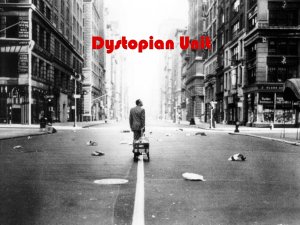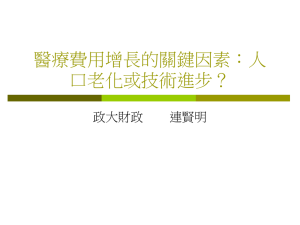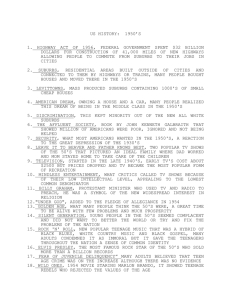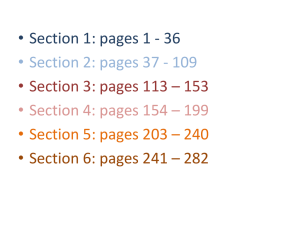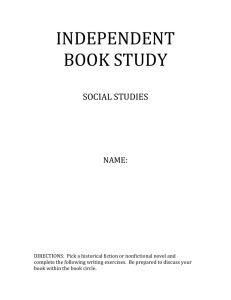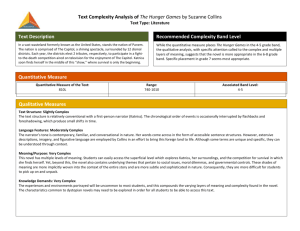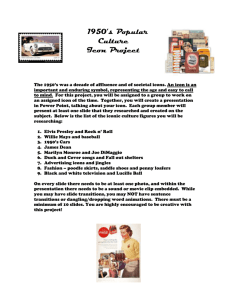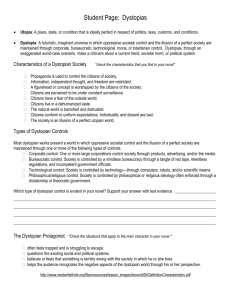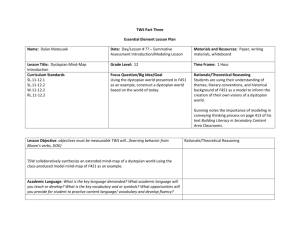File
advertisement
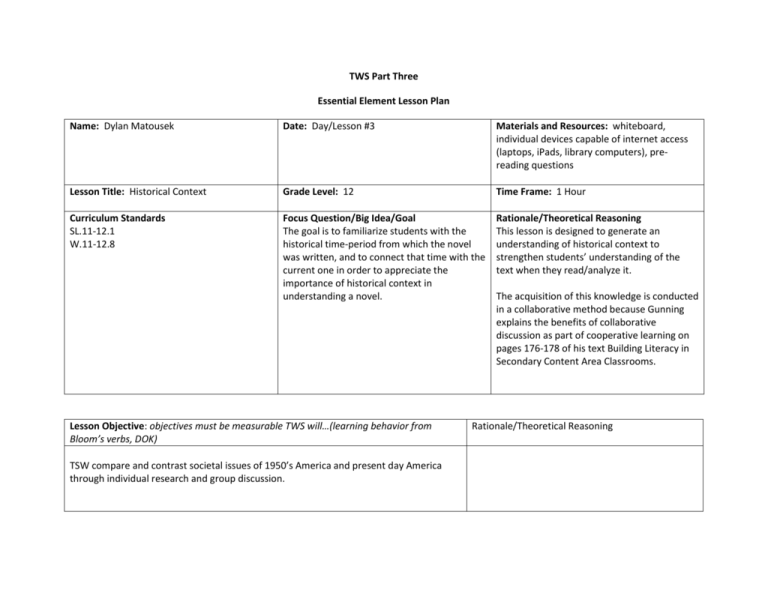
TWS Part Three Essential Element Lesson Plan Name: Dylan Matousek Date: Day/Lesson #3 Materials and Resources: whiteboard, individual devices capable of internet access (laptops, iPads, library computers), prereading questions Lesson Title: Historical Context Grade Level: 12 Time Frame: 1 Hour Curriculum Standards SL.11-12.1 W.11-12.8 Focus Question/Big Idea/Goal The goal is to familiarize students with the historical time-period from which the novel was written, and to connect that time with the current one in order to appreciate the importance of historical context in understanding a novel. Rationale/Theoretical Reasoning This lesson is designed to generate an understanding of historical context to strengthen students’ understanding of the text when they read/analyze it. Lesson Objective: objectives must be measurable TWS will…(learning behavior from Bloom’s verbs, DOK) TSW compare and contrast societal issues of 1950’s America and present day America through individual research and group discussion. The acquisition of this knowledge is conducted in a collaborative method because Gunning explains the benefits of collaborative discussion as part of cooperative learning on pages 176-178 of his text Building Literacy in Secondary Content Area Classrooms. Rationale/Theoretical Reasoning Academic Language: What is the key language demanded? What academic language will you teach or develop? What is the key vocabulary and or symbols? What opportunities will you provide for student to practice content language/ vocabulary and develop fluency? Social Issue -- moral problems that affect a member or members of a society directly or indirectly. Some of these issues include poverty, divorce, bullying, incest, civil rights, corruption, pornography, abortion, abuse, crime, and education. Assessment /Evaluation: Formative: How will student demonstrate understanding of lesson objective(s)? How will you monitor and or give feedback? How will feedback promote student understanding? Students will be assessed by participation in both researching 1950’s American culture and comparing/contrasting that culture to their contemporary one. Students will do this through the completion of the whole-class compare/contrast diagram on the whiteboard. The summary of this activity will be posted to the class Moodle page. Summative: What evidence will you collect, and how will it document student learning/mastery of lesson objective(s)? Working in a group of 3, students will select a facet of their society and twist, hyperbolize, or remove it altogether, as a dystopian text would. Following this, they will create a societal mind-map detailing the conditions of this new dystopian society they have created. Students will then each select a facet of their group-developed society and write a 1 page explanation of how their chosen distortion forms the cause of that facet’s condition. Instruction: Set Motivation/Anticipatory Set: I will recap that in the previous lesson we learned about the ideas of social criticism, utopia, and dystopia. We also learned that the primary purpose of dystopian literature is to criticize aspects of the society in which it is produced. I will begin class by asking students what they know about America in the 1950’s, and recording their responses on one half of the whiteboard titled “1950’s America.” – 10 Minutes Instructional Procedures/Learning Tasks: Provide specific details of lesson content and delivery based on student’s prior knowledge, strengths, and weakness. From there, I will inform students that their job is to expand our understanding of America in the 1950’s by doing some research online. Students will be given time to find out whatever they can about American culture in the 1950’s. I will remind students to use the effective search techniques. (Since they are in 12th grade, they should have a fairly strong grasp of this) – 15 Minutes I will then add the findings from their research to their initial material, and build upon it by adding anything relevant they might have missed (rise of television, suburban expansion, “American Dream”). – 10 Minutes I will then title the other half of the board “Present Day America” and ask students what is different and similar between 1950’s American society and today’s American society. I will supplement student responses with relevant information (rise of computers similar to television, differences in gender roles, similarity in advertisement bombardment, etc.). – 10 Minutes I will then explain the role of historical context in interpreting texts, and how the reader’s historical context can be just as important as the author’s. I will tie this idea back to the purpose of dystopian literature being social criticism and explain that by thinking about the contexts of both the novel and themselves, students have an idea of what sort of societal aspects, and their criticisms, to look out for as they read the novel. – 10 Minutes Questions and/or activities for higher order thinking: These cannot be answered by yes or no. 1. 2. 3. Closure: Verbalize or demonstrate learning or skill one more time. May state future learning. I will close the lesson by recapping student progress up to this point: they have contemplated the purpose of books, discovered the purpose of the specific genre of book they will be reading, created and criticized visions of society, and learned about the historical context the book was produced in. I will then introduce the set of pre-reading questions students are to have completed for the next class period as the final step in getting ready to read the novel. – 5 Minutes Adaptations to meet individual needs: How will you adapt the instruction to meet the needs of individual students? I will upload a summary of the compare/contrast diagram created on the whiteboard to the class Moodle page. This summary will be comprised of information found across all class periods. Management/Safety Issues: Are there any management and/or safety issues that need to be considered when teaching this lesson? I will need to monitor student activity as they are searching for information on the Internet to ensure that they stay on task and remain appropriate. Reflection/Future Modifications: To what extend did the class learn what you intended them to learn? What will be your next steps instructionally? What did you learn about your student as learners? What have you learned about yourself as a teacher? I need to make my expectations of student behavior while searching very clear. This will again be done through the use of my classroom’s previously established codes of conduct. Part of the reason why I want to teach high school is because it is the transitional period from childhood to adulthood. Therefore, I want to foster an environment of maturity and self-responsibility for my students to work in. Granted, this will not work 100% of the time, but I think it is integral to the success of a discussion-based English classroom because of the sometimes controversial subject matter addressed in classroom materials and readings.
